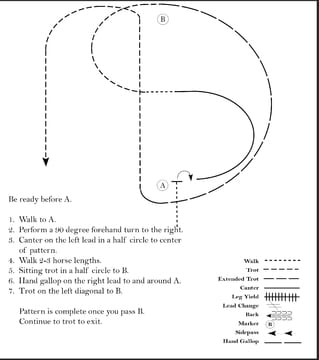AQHA judge and multiple World and Congress Champion trainer, Holly
Hover of Cave Creek, Arizona was kind enough to break down the Congress Amateur Equitation
pattern for us. Her training program revolves around the preparation of the all-around horse and rider. She has instructed 15 World or Reserve World Champions between the AQHA, AQHYA, APHA, and NSBA World Championship shows. She has had riders earn all-around and reserve all-around titles at both the Quarter Horse Congress and the AQHA World Show. As a carded AQHA, NRHA, NSBA, and APHA judge, she has had the privilege of judging World Shows and major events for all associations.
We thought it would be beneficial to our
readers to find out from an AQHA Judge whose customers have had success
in this class, how the patterns should be executed. We would also like
to thank HorseShowPatterns.com
for letting us post the pattern in the article as well as provide a
link to the pattern. Please print out the pattern and follow along or click here to download the pattern.
Check out Holly’s breakdown below!
Amateur Equitation Pattern Breakdown
- This is an excellent pattern. I think it will serve as an accurate barometer for the judges’ to assess the skills of the riders as well as being a pattern that will challenge and showcase the exhibitors abilities.
- Be ready before A
- Walk to A. I would expect the rider to be in position a few walking steps before marker A. Since it does not define an exact starting point, I would place yourself a comfortable distance from A as to show a quiet entrance to your pattern.
- Perform a 90 degree forehand turn to the right. The line of travel shows you leaving in a straight line away from the marker. This will be made easier if you position and maintain your horse’s front feet across from A throughout the forehand turn. A forehand turn to the right is done so by moving your horse away from your right leg. The horse should yield with no resistance. Be cautious not to rush into an over or under turn. This is not a race–be confident and take your time.
 Canter on left lead in a half circle to center of pattern. I would be cautious of this transition. You may want to make sure your turn is complete, take a breath and then ask for the canter departure. Some horses may just keep pushing away from your right leg and not move correctly into the canter unless you separate the two maneuvers. Some horses actually need a walk step forward before they depart, and I think this is perfectly acceptable. You are then expected to find the center of your pattern so look forward and do just that while keeping in mind the balance of your entire pattern and equal distances of your lines of travel in the arcs as well as distances from the markers. Very often riders lay out a ‘lopsided’ pattern.
Canter on left lead in a half circle to center of pattern. I would be cautious of this transition. You may want to make sure your turn is complete, take a breath and then ask for the canter departure. Some horses may just keep pushing away from your right leg and not move correctly into the canter unless you separate the two maneuvers. Some horses actually need a walk step forward before they depart, and I think this is perfectly acceptable. You are then expected to find the center of your pattern so look forward and do just that while keeping in mind the balance of your entire pattern and equal distances of your lines of travel in the arcs as well as distances from the markers. Very often riders lay out a ‘lopsided’ pattern.
- Walk two to three horse lengths, that is somewhere between six to 12 walking steps. I would make that determination after you have practiced and seen what is most comfortable for your horse. The pattern leaves this up to you. I would expect the judges to be looking for a balanced downward transition….something that will showcase the rider who has a good connection with their horse.
- Sitting trot in a half circle to B. I would think that a bold move into a working trot would certainly improve your score. It will emphasize your strong leg, deep seat, your hand to mouth connection with your horse. Be careful of a break of gate here, move forward in a controlled manner.
- Hand gallop on the right lead to and around A. Be sure to take up your reins and maintain connection with your horse as you move into the two point position and the hand gallop. Think about what the hand gallop is……this is not a reining pattern, rather a test as a prerequisite to an over fences rider. Move your horse forward, lengthen his stride as you would need to in a working hunter event. This is not a place for the “the stand, point and kick!” Use your eyes, build your arc and move forward to marker A. It shows a fairly tight corner around A but use your area and know what your horse can handle.
- Trot on left diagonal to B. As soon as you have rounded your corner and established a straight line, drop into your left diagonal. It is asking you to do this from the two point…a highly skilled test of your feel. Eyes up and get that diagonal! Continue in a straight line to marker B
- Pattern is complete once you pass B….Continue to trot to exit. Although it says pattern is complete as you pass B the diagram distinctly shows you arcing left and exiting down the side rail. Do not go around the corner on the incorrect diagonal. I would change diagonals or take the sitting trot to exit!
Good Luck, Be Brave and Have Fun!






